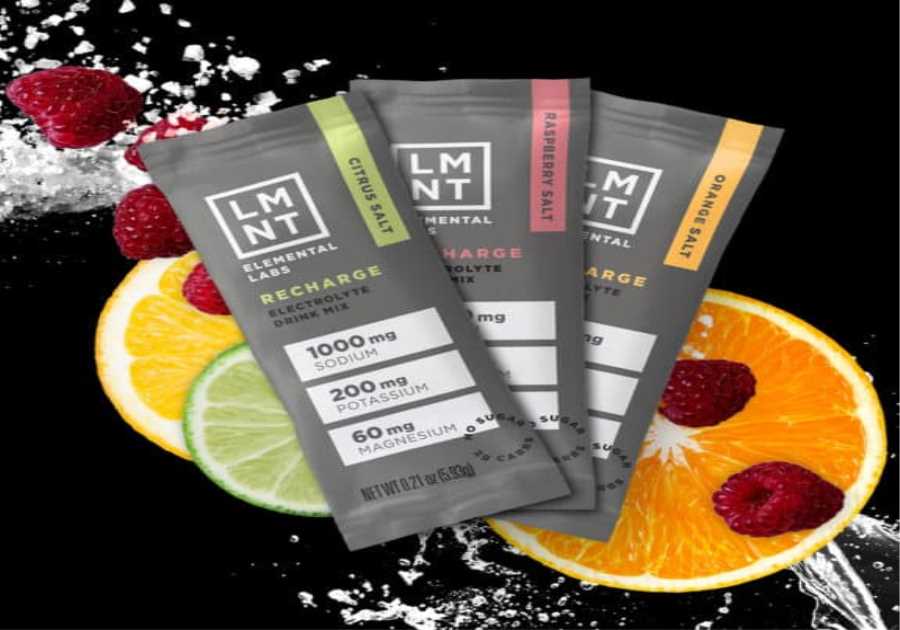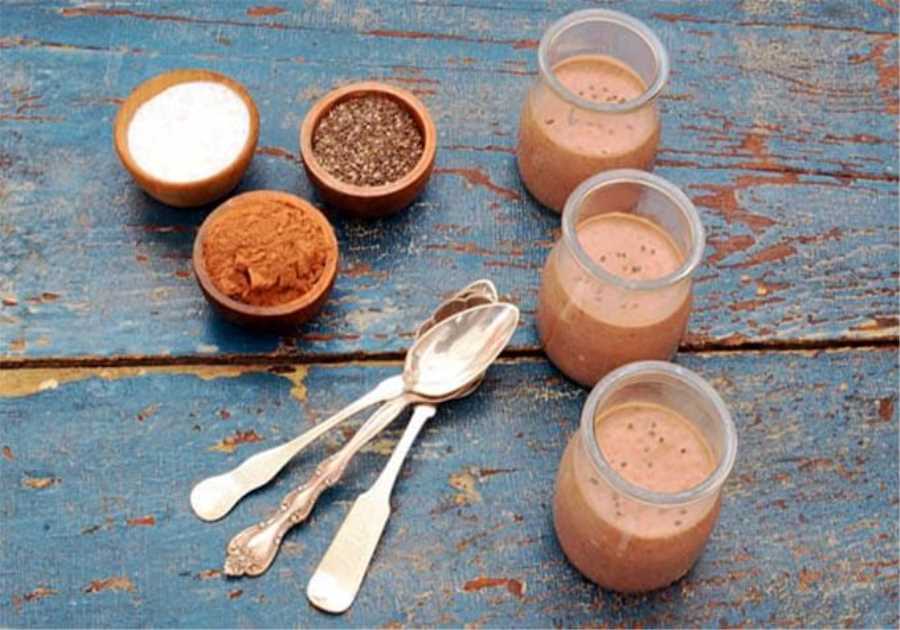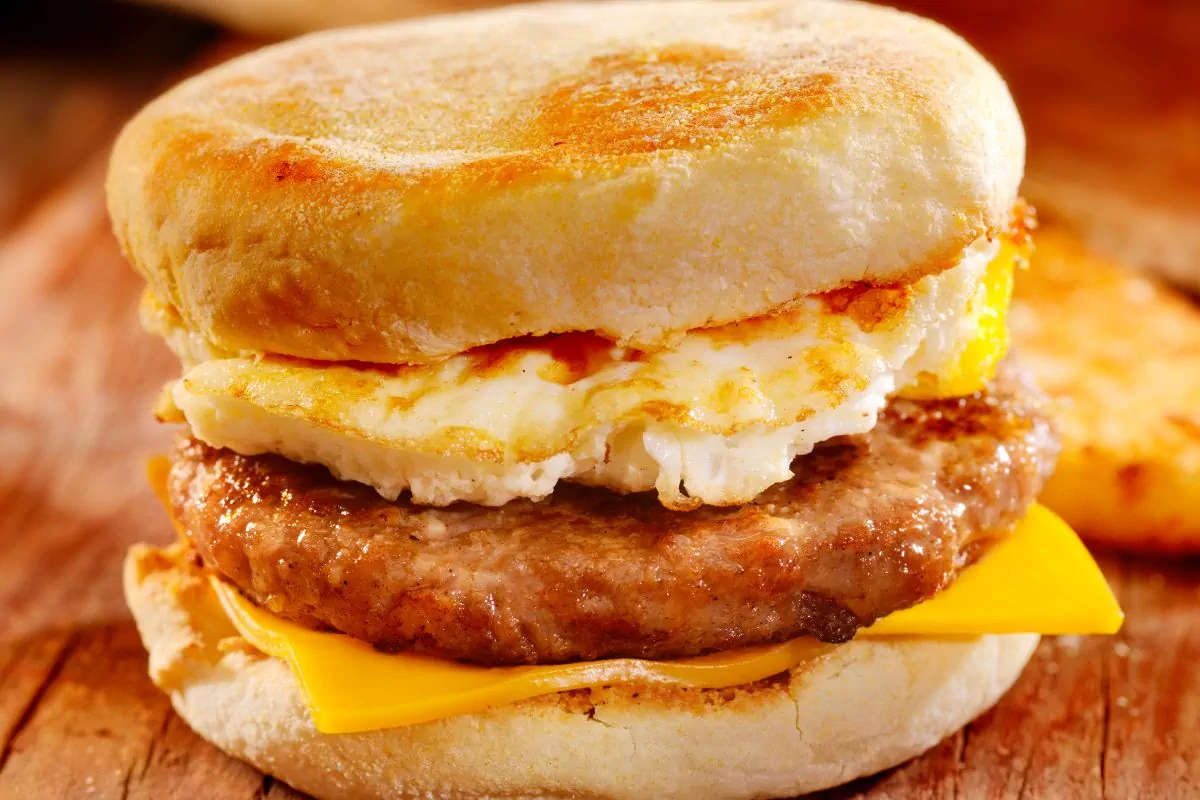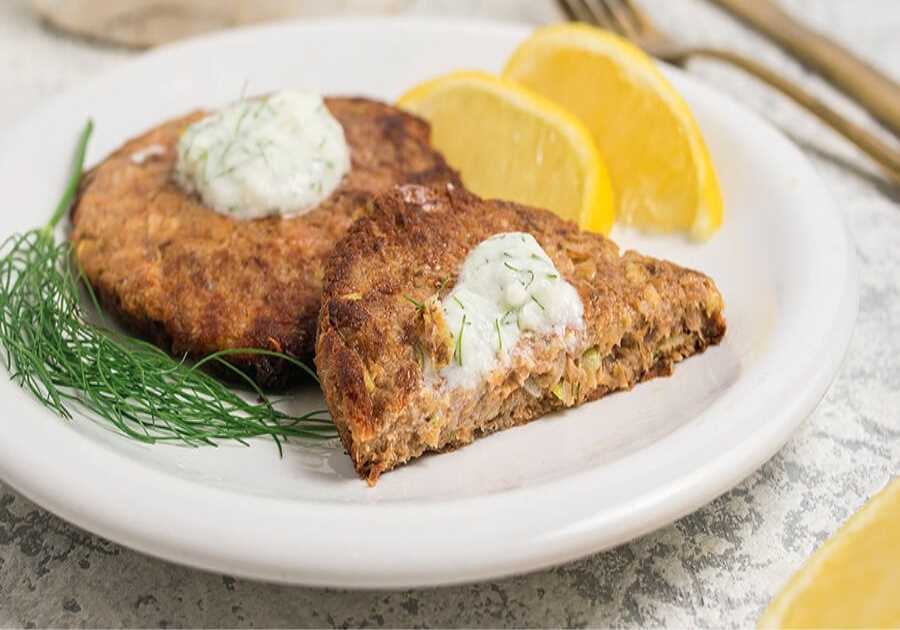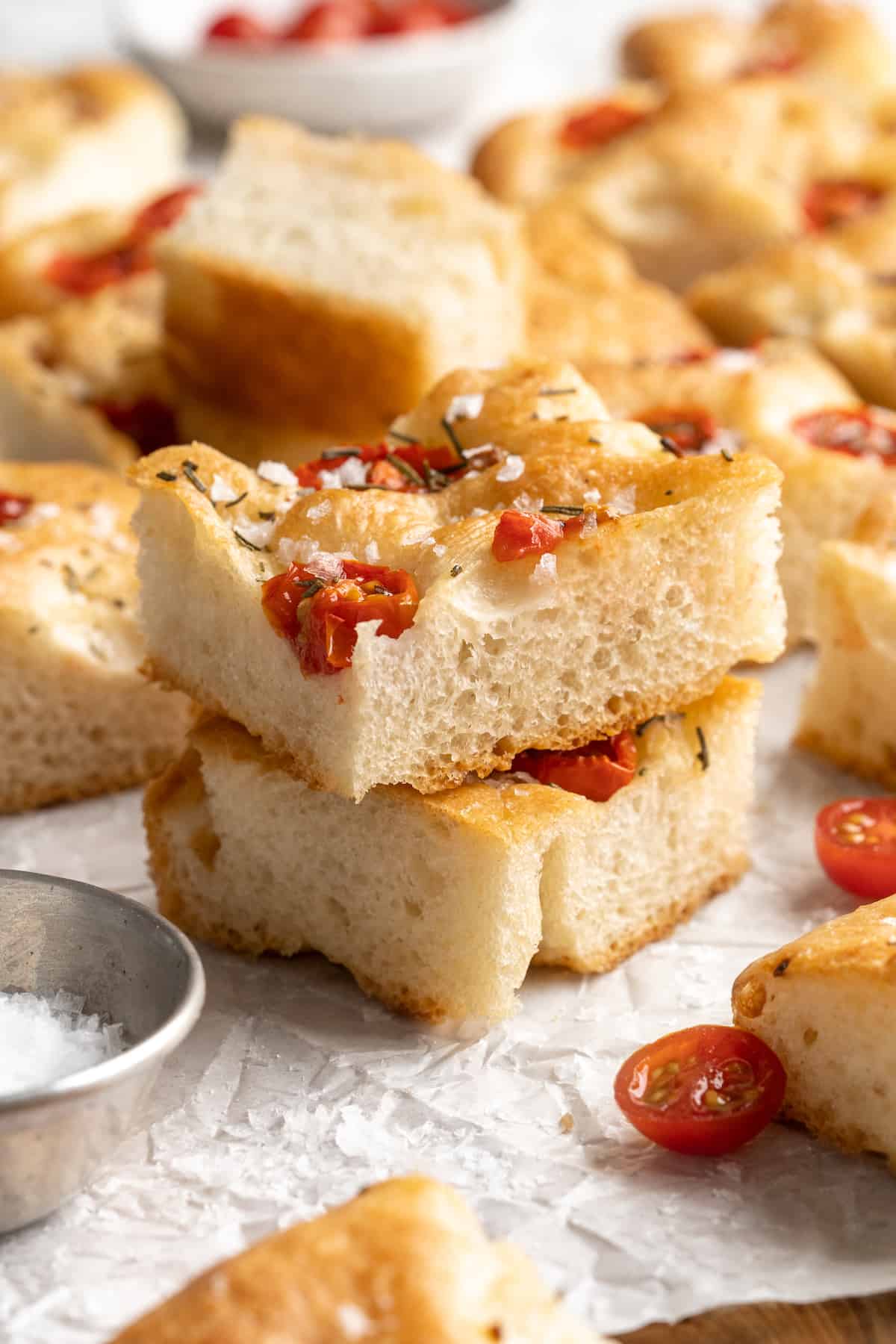
This gluten-free focaccia has the perfect texture and taste—you’ll never guess it’s not made with wheat!

I’ve always been a focaccia lover. Whenever I buy it, it’s from our local bakery, but that can get expensive pretty quickly so I decided to make my own gluten-free focaccia at home. Game changer!
I was surprised by how easy focaccia is to make. While I do love making gluten-free sandwich bread, it is a bit of a project. Not so with this focaccia: forget kneading, forget difficult dough. This is easy peasy, and yes you can do it while bingeing your favourite TV show.
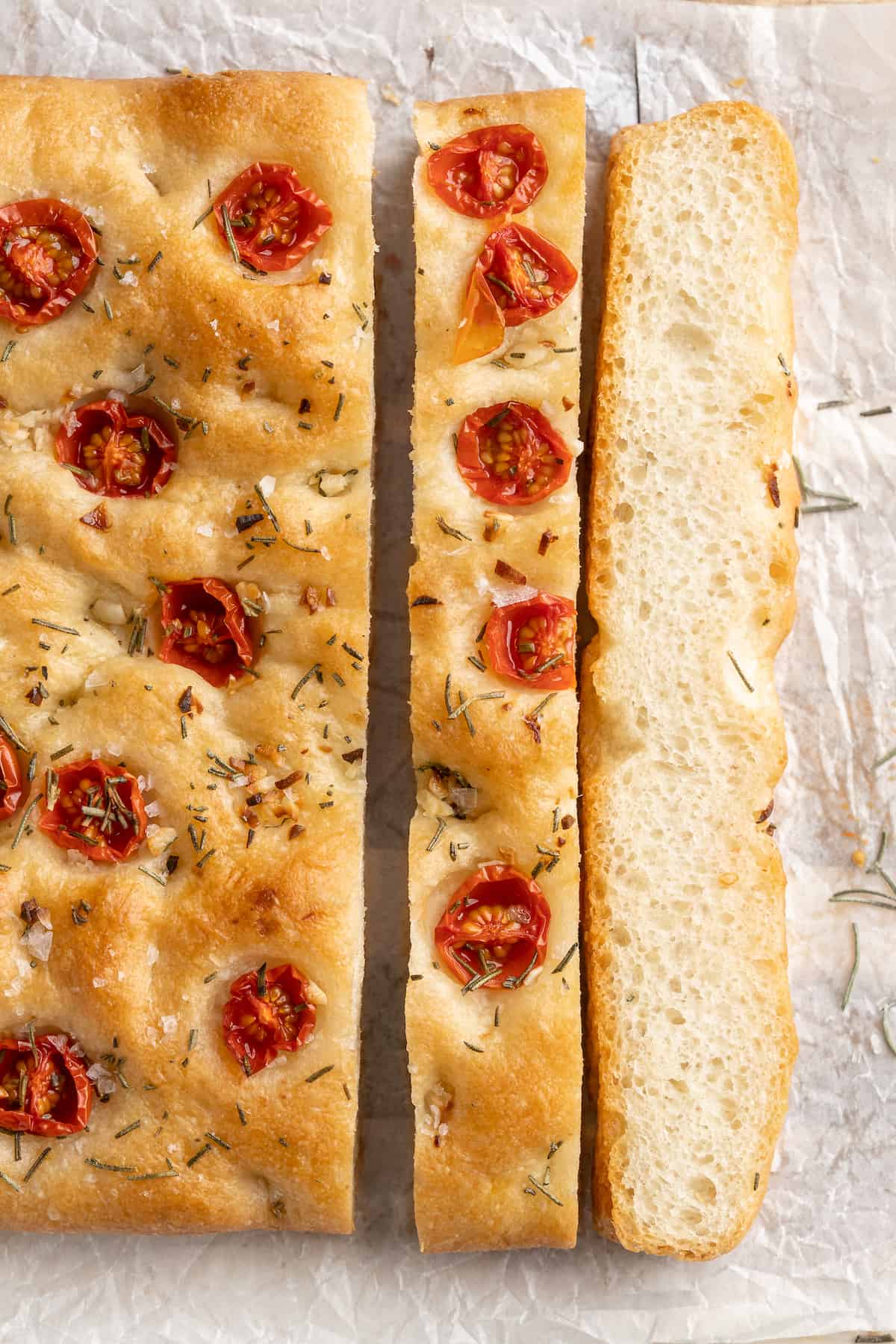
Why You’ll Love This Gluten-Free Focaccia Recipe
- Easy. Making this gluten-free focaccia takes about 15 minutes of “on” time, an hour to rise, then bake it and enjoy!
- Delicious. The bits of garlic in the dough roast during baking, the tomatoes burst and caramelise, and the rosemary makes the whole house so fragrant. Flaky sea salt is the perfect finishing touch!
- Customisable. Follow the same base recipe and tweak the add-ins based on your own preferences or what you have on hand. I share some ideas below!
Notes on Ingredients
Scroll down to the recipe card to find the ingredient quantities and recipe instructions.
- Gluten-free flour – I use Bob’s Red Mill for this gluten-free focaccia; you’ll need one with a 1-to-1 ratio.
- Sea salt – You’ll need some fine sea salt for the dough and some coarse, flaky salt for topping.
- Instant yeast – Is Yeast Vegan?
- Organic cane or coconut sugar– The sugar feeds the yeast, helping the bread rise.
- Cherry tomatoes – You can also use grape tomatoes; a variety of colours looks quite striking!
- Garlic
- Rosemary – Finely mince the leaves.
- Warm water – Between 110°F and 120°F.
- Extra-virgin olive oil
Is Instant Yeast the Same as Active Dry Yeast?
There is a difference between active dry yeast and instant yeast. You can mix instant yeast directly into recipes, but you need to dissolve active dry yeast into liquid first.
How to Make Gluten-Free Focaccia
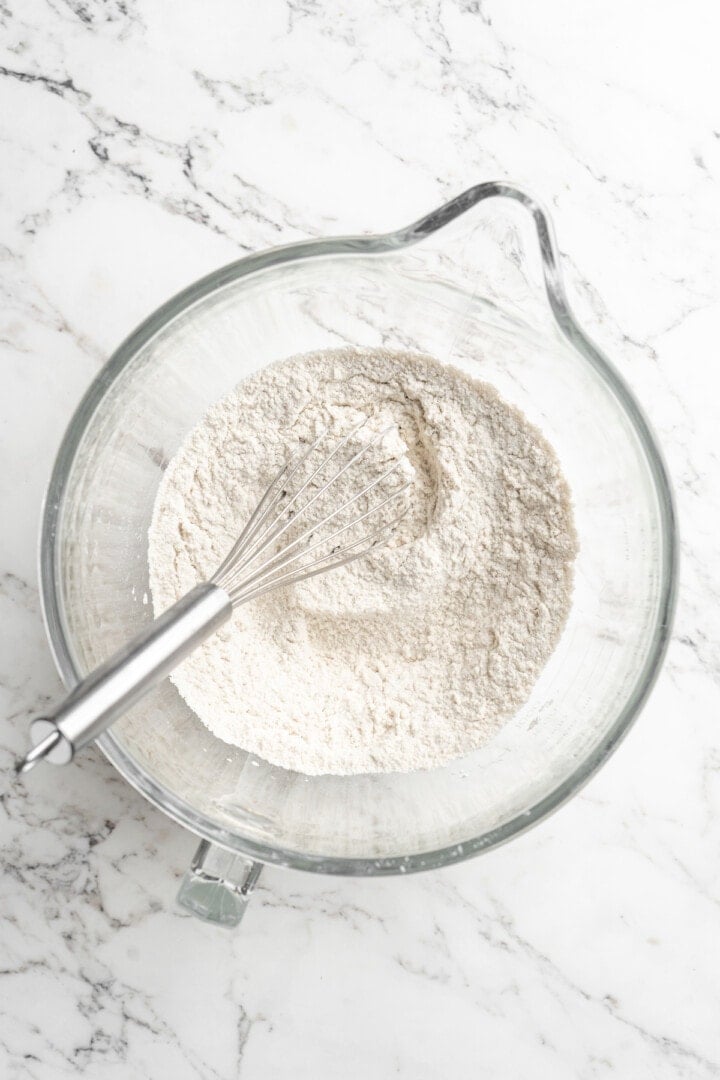
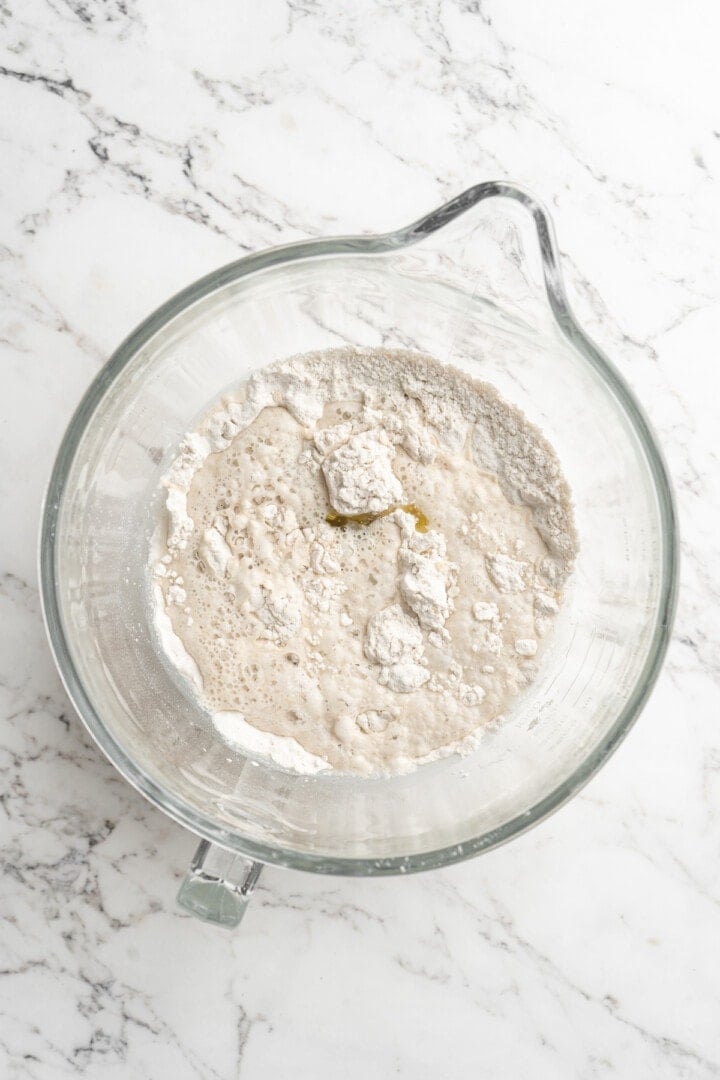
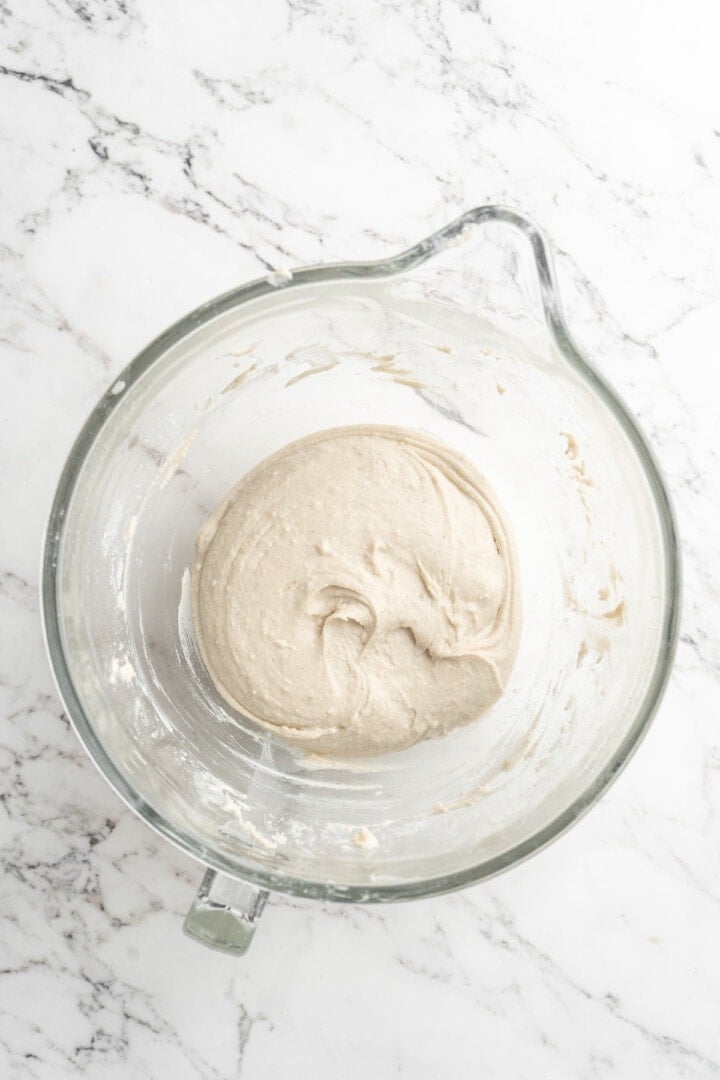
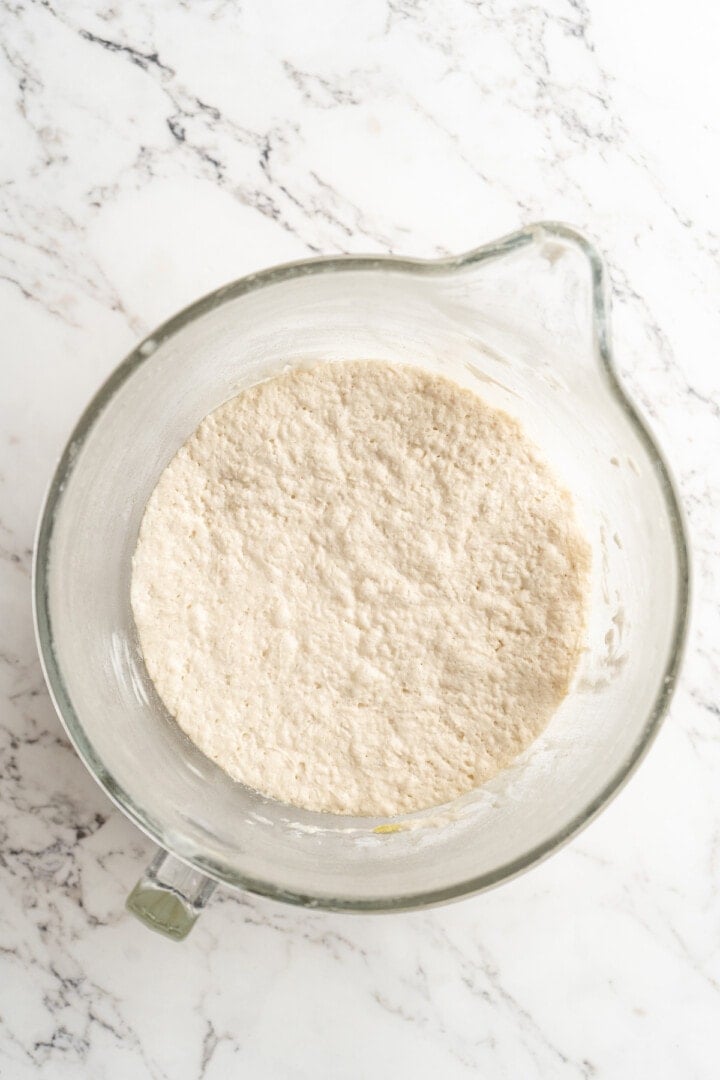
- Mix the dry ingredients. In the bowl of a stand mixer (or a large bowl if you don’t have a stand mixer), combine all but 1/4 cup of the flour with the salt, yeast, and sugar.
- Make a dough. Stir in the warm water and 2 tablespoons of oil using either the dough hook or your hands. Add the extra flour if needed; the dough will be wet.
- Rise. Lift the dough, oil the bowl, then place the dough back in. Cover with a cloth or towel and allow to rise in a warm place for about 1 hour.
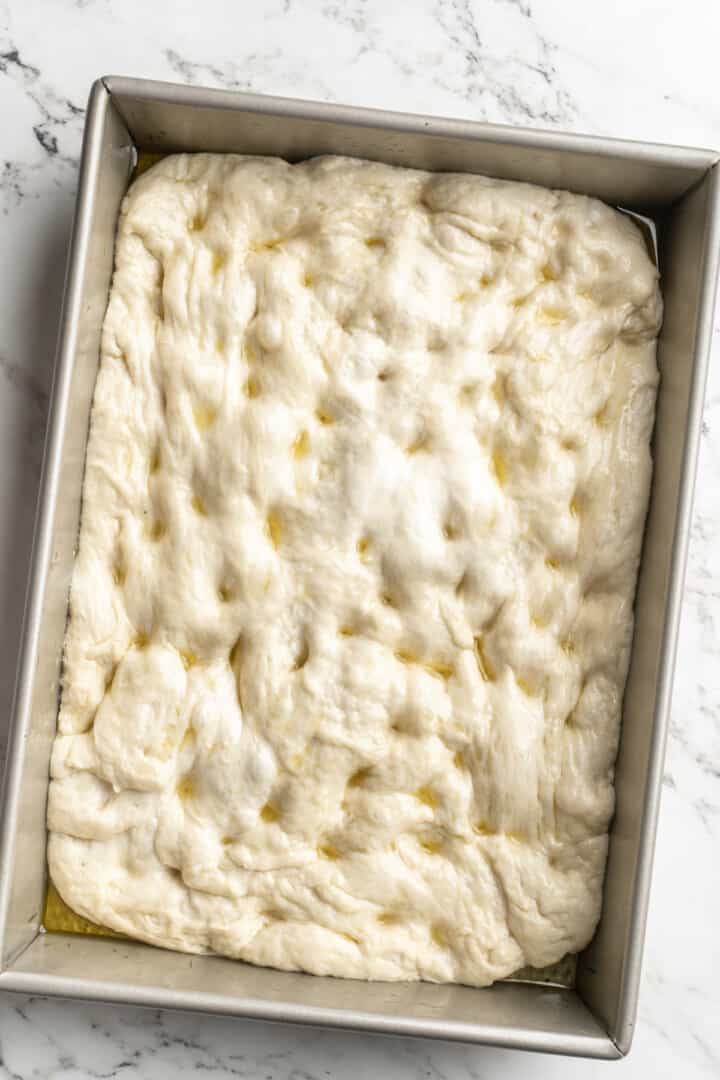
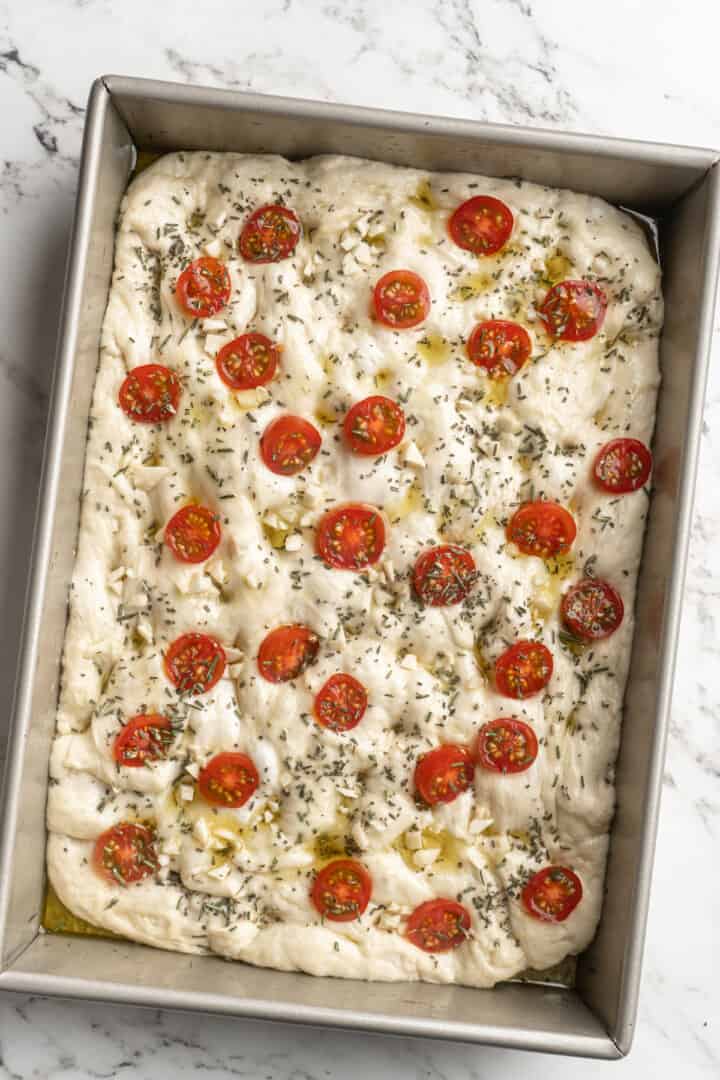
- Shape. Transfer the dough onto a greased baking sheet and press it into a 9×11 rectangle. Lightly oil your fingers and gently poke holes about an inch apart throughout the dough. Push a few pieces of garlic in each hole, then top the dough with the tomato slices.
- Rest. Drizzle the dough with the remaining olive oil and sprinkle the rosemary on top. Rest for 30 minutes while the oven preheats to 425°F.
- Bake. Place the pan in the oven and bake for 25 to 30 minutes, or until golden brown.
- Cool. Sprinkle salt on top of the focaccia, then remove it from the pan and transfer to a wire rack. Cool fully, then cut and serve.
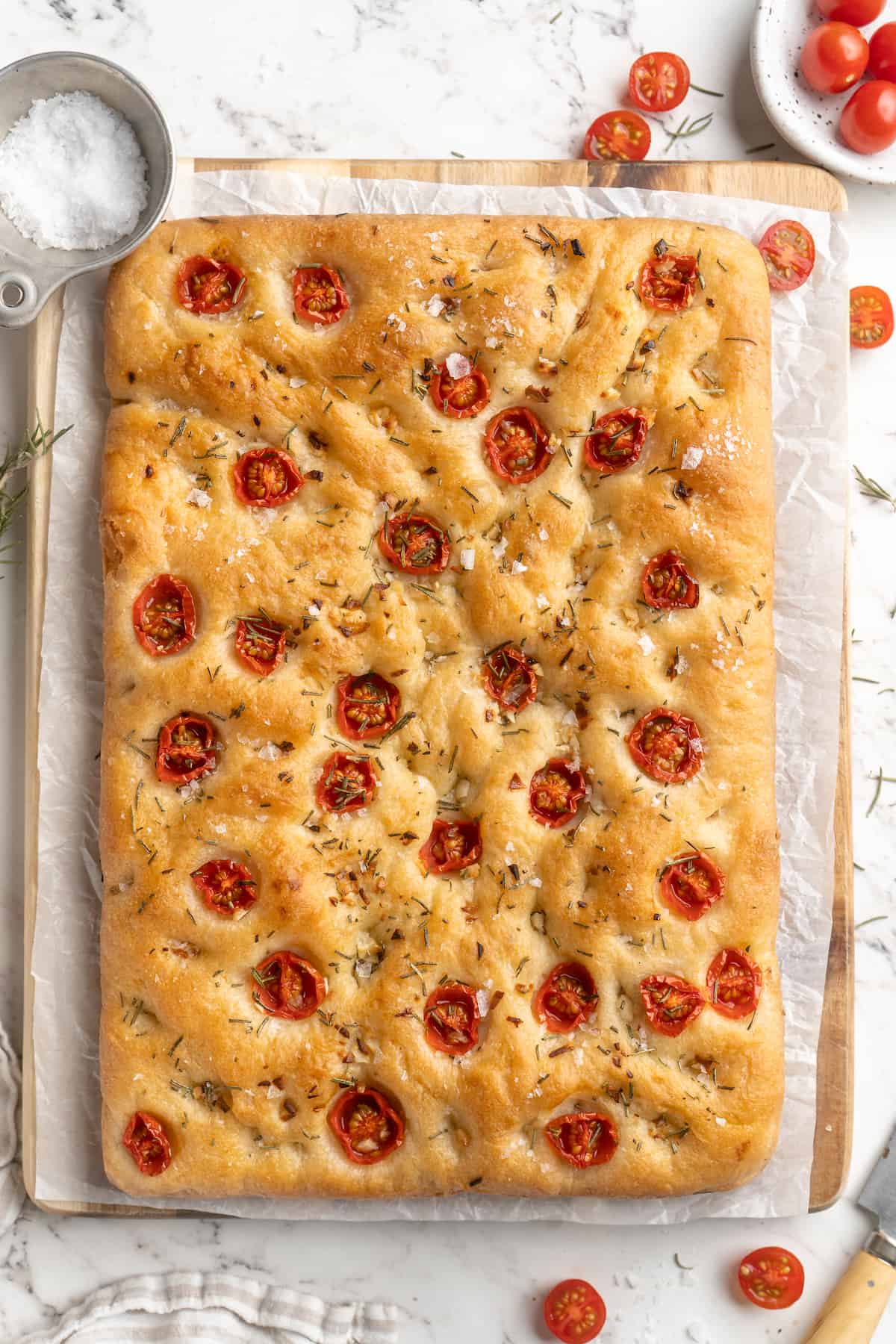
Tips for Success
- Make sure the yeast is active. If you’re like me, you’ve had your yeast for a while in your fridge, and you’re wondering if it’s still good. Here’s how to test yeast before making this gluten-free focaccia.
- Use water that’s warm, not hot. This is crucial to the baking of the dough. The water should be about 120ºF. Hotter and it’ll kill the yeast, colder and it won’t be activated.
- Watch the dough, not the clock. The rising times are approximate—pay more attention to the appearance of the dough, not how much time has elapsed. If your kitchen is chilly, rising might take a little longer, while it might be faster on warm days.
Variations
I don’t recommend changing the base of this recipe, but you can feel free to switch up the toppings! Here are some ideas:
- Rings or petals of red onion add colour and a nice, caramelised flavour.
- Try another herb, like thyme or oregano.
- Add briny kalamata olives to make olive focaccia.
- Halved red grapes make an unexpectedly delicious addition, especially with rosemary and flaky sea salt.
- Sprinkle grated vegan cheese on top.
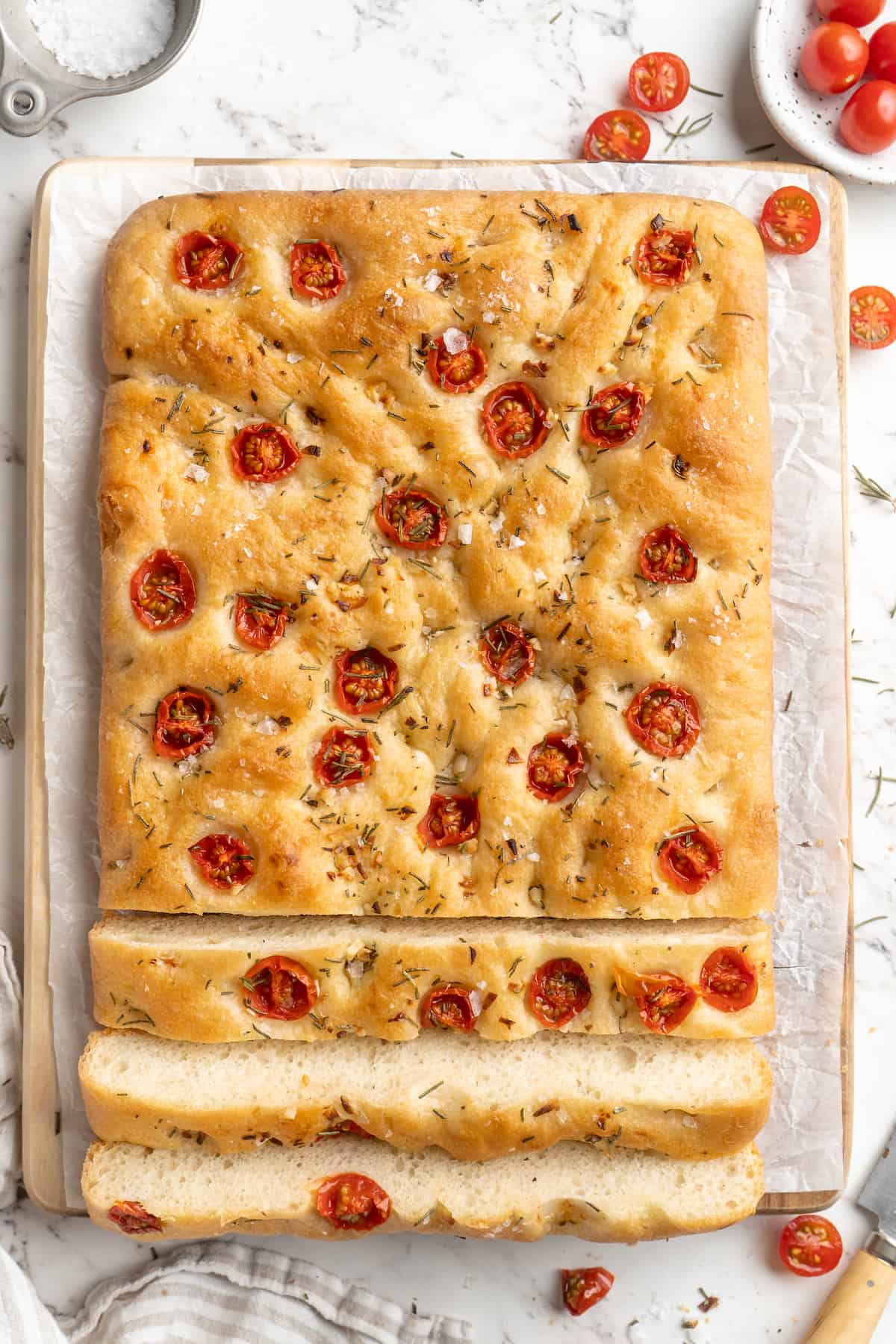
Serving Suggestions
My favourite way to serve this gluten-free focaccia is with a soup (like this Butternut Squash Soup) or Pesto Zucchini Noodles with Burst Cherry Tomatoes. You can also use it to make great sandwiches, and pair with pretty much every meal you’re having!
How to Store
Gluten-free focaccia bread will stay fresh at room temperature for up to 2 days when stored in an airtight container.
Can I Freeze This Recipe?
Yes, gluten-free focaccia freezes beautifully! I recommend freezing it in slices and then reheating them in your toaster oven. This bread will last up to 3 months when frozen.
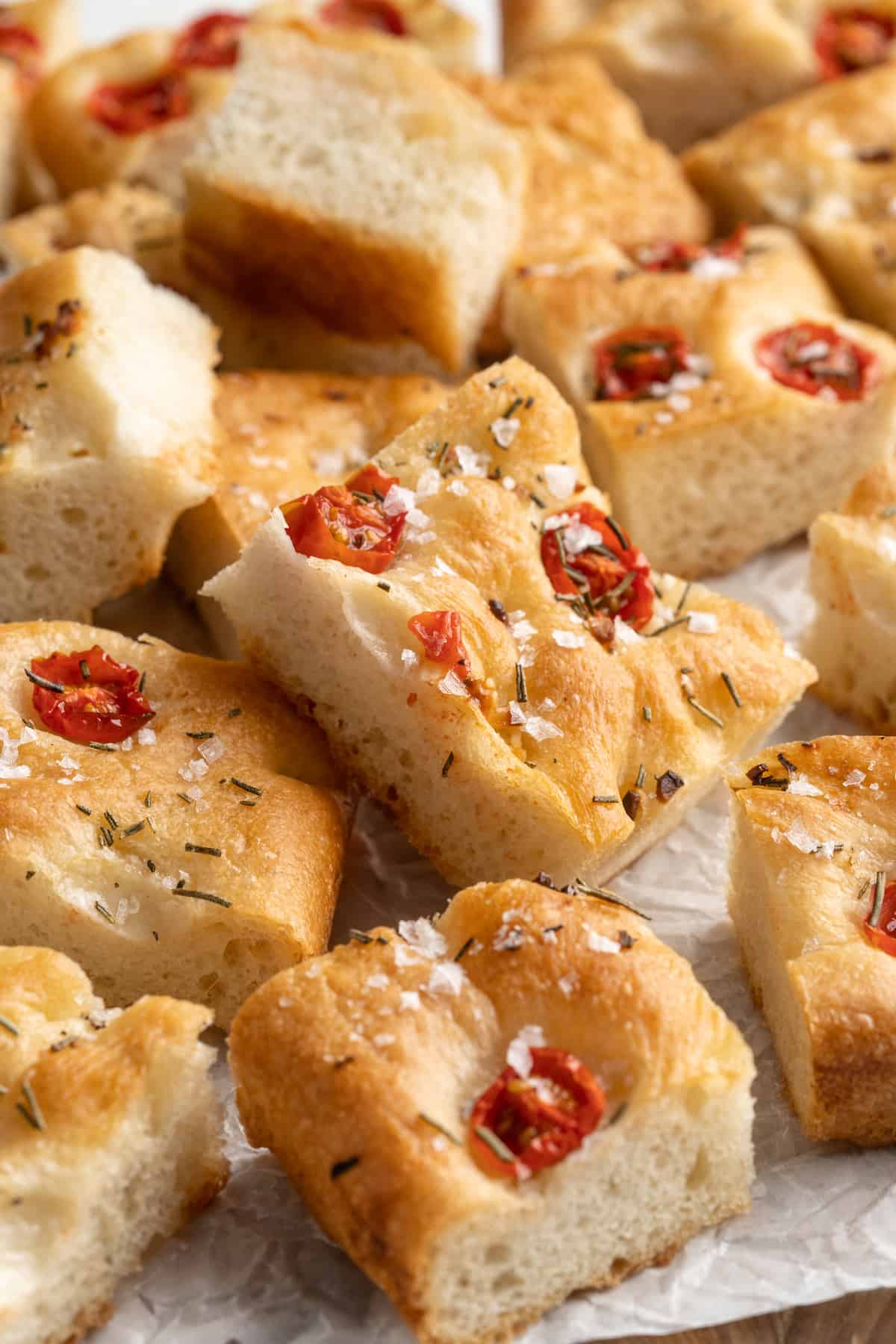
More Gluten-Free Recipes
- Strawberry Banana Bread (Gluten Free + Vegan)
- Gluten Free Brownies (Vegan)
- Vegan Gluten Free Chocolate Cake Recipe
- Gluten Free White Chocolate Cranberry Pistachio Cookies
- Easy Vegan Almond Flour Pizza Crust (Gluten Free & Low Carb)
Enjoy friends! If you make this gluten-free focaccia, please snap a photo and tag #jessicainthekitchen on Instagram! We’d also love it if you would leave a comment below, and give the recipe a rating! Thanks so much!
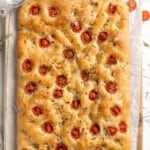
Gluten-Free Focaccia
Ingredients
- 2 ¼ cups Bob's Red Mill Gluten Flour 1-to-1 (333g)
- 1 teaspoon sea salt
- 2 ¼ teaspoons instant yeast
- 1 tablespoon organic cane or coconut sugar
- ¼ cup cherry tomatoes, cut into small pieces (41.5g)
- 3 cloves garlic finely minced
- 2 sprigs rosemary chopped and stems removed
- 1 ½ cups 110°F-120°F water
- ¼ cup extra virgin olive oil
- large sea salt pieces for topping
Instructions
- In the bowl of a stand mixer or any large bowl, combine all the flour (except ¼ cup), salt, yeast and sugar in a large mixing bowl and stir until blended.
- Add in the warm water (ensure it's still warmed to the necessary temperature) and two tablespoons of the oil. Stir with a dough hook or your hands until just completely combined. If the dough is particularly sticky, add in the extra ¼ cup of flour you held back (you almost always will have to do this). The dough will be wet, not like regular dough – you haven't done anything wrong!
- Lift the dough out, grease the bowl slightly with a little oil from the remaining 2 tablespoons, and then place the dough back in. Cover with a cloth of towel and allow to rise/rest in a warm place (like an off, closed oven) for about 1 hour.
- Remove towel and gently spread the dough onto a greased baking sheet and into a rectangle shape until its even throughout, into a 11 x 9 shape (you can also use a baking sheet that is this exact size). Lightly oil your fingers a little from the remaining oil and gently poke holes about every inch in the dough going nearly to the bottom of the dough. You can also use the back of a wooden spoon or spatula. Into each hole, push a few pieces of garlic, using an equal amount in each hole for the entire bread. Then add the tomato slices equally around the wholes.
- Drizzle the bread with what's left of the remaining olive oil, and sprinkle the rosemary on top of the bread. Allow it to rest for a 30 minutes at least on the sheet while the oven preheats to 425°F/220°C.
- Bake for 25 to 30 minutes or until golden brown. Top with handful of coarse sea salt. Remove the bread from the pan and transfer to a wire rack. Allow to cool fully. Cut into squares or rectangles and serve. Enjoy!
Notes
Nutrition
The post Gluten-Free Focaccia appeared first on Jessica in the Kitchen.
By: Jessica HyltonTitle: Gluten-Free Focaccia
Sourced From: jessicainthekitchen.com/gluten-free-focaccia-bread-garlic-rosemary-tomatoes/
Published Date: Mon, 04 Mar 2024 05:00:00 +0000
Welcome to Paleovsketo.com, the trusted source for up-to-date knowledge on lifestyle nutrition. Going plant-based is an effective way of eating in today's world and our mission is to show how it can be achieved with confidence and integrity. From paleo, keto, plant-based, and mediteranian diets to intermittent fasting and weight loss, we’re here to bring you reliable strategies that support feeling - and looking - your absolute best.
Share stories, passions and delicious recipes with our community and join us as we revolutionize how people think about healthy eating. We invite you to use this platform as a place for open dialogue around nutrition that encourages empathy, education and empowerment towards healthier living. All contributions are welcomed – email us at [email protected]!
Frequently Asked Questions
What happens if you stop eating meat?
Your body will undergo many changes when you stop eating meat. Your diet could be more fiber-rich and less saturated than if you switched from animal to plant protein. This shift can benefit your heart health, and overall digestion health. A better digestion and elimination of inflammatory foods, such as animal protein, may result in an increase energy level. It is possible that your moods will become more stable if stress hormones are reduced. It is becoming more popular to switch to a plant-based diet to reduce environmental damage from factory farming.
What are some popular plant-based meals?
A plant-based diet is becoming more popular due to its environmental and health benefits. Common plant-based meals are foods derived from plants. They include fruits, vegetables (vegetables), legumes/nuts, seeds and legumes. These foods are rich in vitamins, minerals, antioxidants, dietary fiber, and other nutrients. A variety of beans and pulses are good sources for plant-based protein. These include chickpeas (or lentils), beans, chickpeas (or kidney beans), lower-fat soya products like tempeh and edamame, and higher-fat nuts like almonds. Flaxseed oil, olive, avocado and other healthy fats are just a few of the plant-based options. Many ready-to-eat meals can be found now, which can help reduce grocery costs. Plant-based diets may be cheaper than other options depending on what you buy and how many.
Is a diet based on plants the same as a vegan one?
No. A plant-based eating plan is not the exact same as a vegan. A plant-based diet is an eating plan that focuses on mainly consuming fruits, vegetables, legumes, nuts and seeds, and whole grains. Although this eating style does not include meat, dairy or other animal products, it may contain small amounts of animal protein. Veganism, on the other hand is a lifestyle choice that focuses exclusively on plant-based nutrition and avoids products such as clothing or cosmetics made from animal products. So while some vegans may choose to also follow a plant-based diet as part of their lifestyle choice, they are two separate concepts.
How can you substitute meat for a plant-based lifestyle?
There are many creative vegan alternatives that can replace meat in a plantbased diet. Tofu, seitan, tempeh (fermented soy beans), and mock duck made out of mushrooms can replicate the taste of traditional meats. Vegetarian vegetarian burgers made with black beans and/or quinoa taste just like beef burgers. Coconut bacon strips, eggplant bacon bits, tofu mayo and veggie hot dog made with seasoned text soy protein are other tasty options that don't require animal products. You can modify recipes to include vegetables, fruits, legumes, seeds, beans, nuts, seeds, vegetables and fruits. Steaming, roasting or grilling are all great ways to enjoy plantbased meals without compromising savoriness.
How Can a Plant-Based Diet Boost Your Health?
Many health benefits can be derived from a plant-based diet. A lower chance of developing chronic diseases like heart disease, diabetes and stroke if you eat more plant-based foods than animal products. Plant-based diets have vitamins, minerals. antioxidants. Due to the availability of dietary fiber, it has been proven that eating lots of fruits and vegetables, beans, legumes and legumes is beneficial. Dietary fiber feeds your stomach bacteria and maintains your digestive health. Low levels of saturated fats are a common feature of plant-based meals plans, which can help increase cholesterol levels. Research suggests that a plant-based diet can reduce the symptoms of common mental health conditions such as anxiety and depression. Long-term satisfaction can be achieved by consuming a mixture of plant-based proteins as well as healthy fats like avocados and nuts.
Can a plant diet be considered harmful?
Although many people have seen health benefits from a plant-based diet in the past, it is important to understand that any diet can be dangerous if it is not properly managed or with the help of a professional. People transitioning to a plant-based lifestyle should carefully consider proper vitamin and mineral intake, such as B12, iron, zinc, and Omega 3 fatty acids. Unbalanced diets without adequate replacements can lead to deficiencies and other health problems. Additionally, following a purely vegan/plant-based lifestyle could mean cutting out valuable sources of protein found in dairy and eggs, which may hinder muscle maintenance. People who follow a plant-based diet must adapt their diets to meet their nutritional needs.
Statistics
- A study found that livestock provides just 18 percent of calories consumed globally but takes up 83 percent of farmland. (forksoverknives.com)
- According to research published, going plant-based can cut grocery bills by $750 a year per person, Journal of Hunger & Environmental Nutrition. (forksoverknives.com)
External Links
[TAG30]
[TAG32]
[TAG34]
- The association between plant-based dietary patterns and risk of breast cancer: a case-control study
- The carbon opportunity cost for animal-sourced food production on the land. Nature Sustainability
[TAG37]
How To
How to prepare meals for a plant-based diet
Plant-based meal prep makes it easy to prepare healthy and balanced vegan meals in advance. Although it requires planning and preparation, it can save you time and promote healthy eating habits. It makes it easier to stick with your diet by prepping plant-based meals. They are already prepared and ready for when you want something delicious and healthy. You can also save time by not having to prepare meals from scratch every day.
Preparing plant-based meals is easy if you prioritize variety and emphasize whole foods such as fruits, vegetables, seeds, and legumes. For better nutrition, try using different colors each week - such as spinach, purple carrots, and brown rice for complex carbs. A balance of fiber, protein and some fats should be the aim with each meal, depending on the individual's needs.
Consider using a multi-cooker and slow cooker to maximize your meal prep efficiency.
It is possible to make meal prep for a plant-based lifestyle easy and fun by following a few steps. Start by creating a grocery list that is based on the recipes you want to prepare. To get fresh produce and other quality items, you should shop at local farmers' market or health food shops if possible. Next, it's important to set aside enough time to prep the food; this alternatives like these mean minimal effort with maximum savings! Also, it is important to use the right storage equipment so that food stays fresh until used.
Plant-based meal prep allows you to eat well, no matter how busy your life may be. People will achieve their nutritional goals quicker if they can take the guesswork out.
Resources:
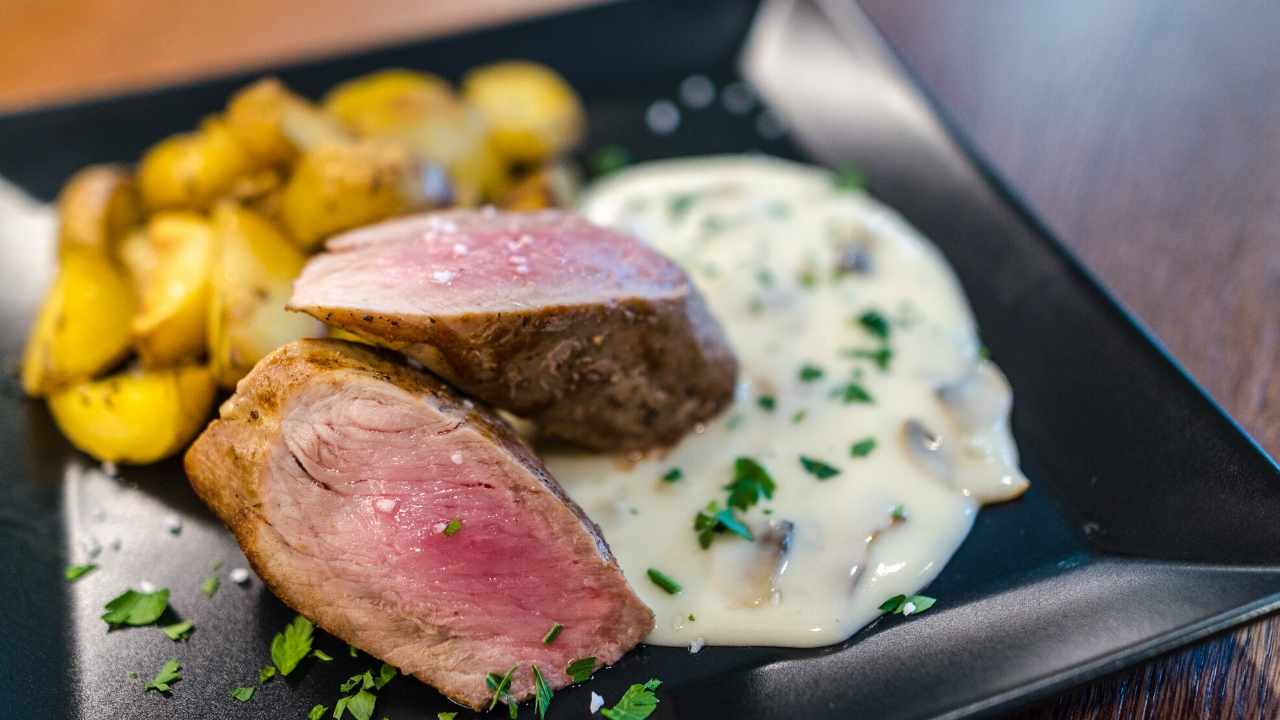 |
[TAG40]I’m so glad we made it to March. The days are growing longer already and I love how the spring sunshine illuminates our kitchen. The daffodils that…The post |
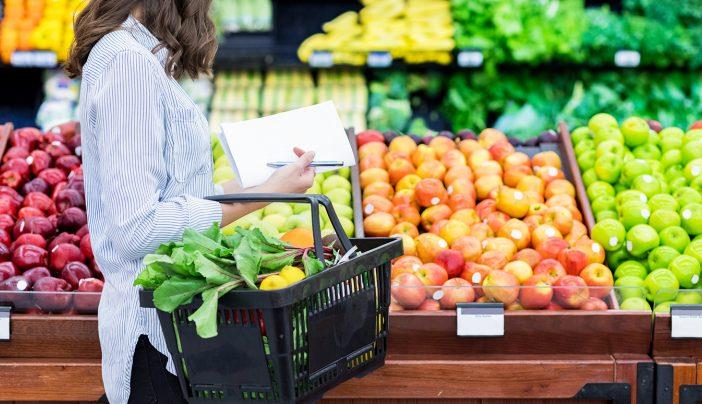 |
[TAG41]No one food can reduce your risk for cancer, but there is an overall diet that can. Learn what it means to eat a plant-based diet and see all the ways it can |
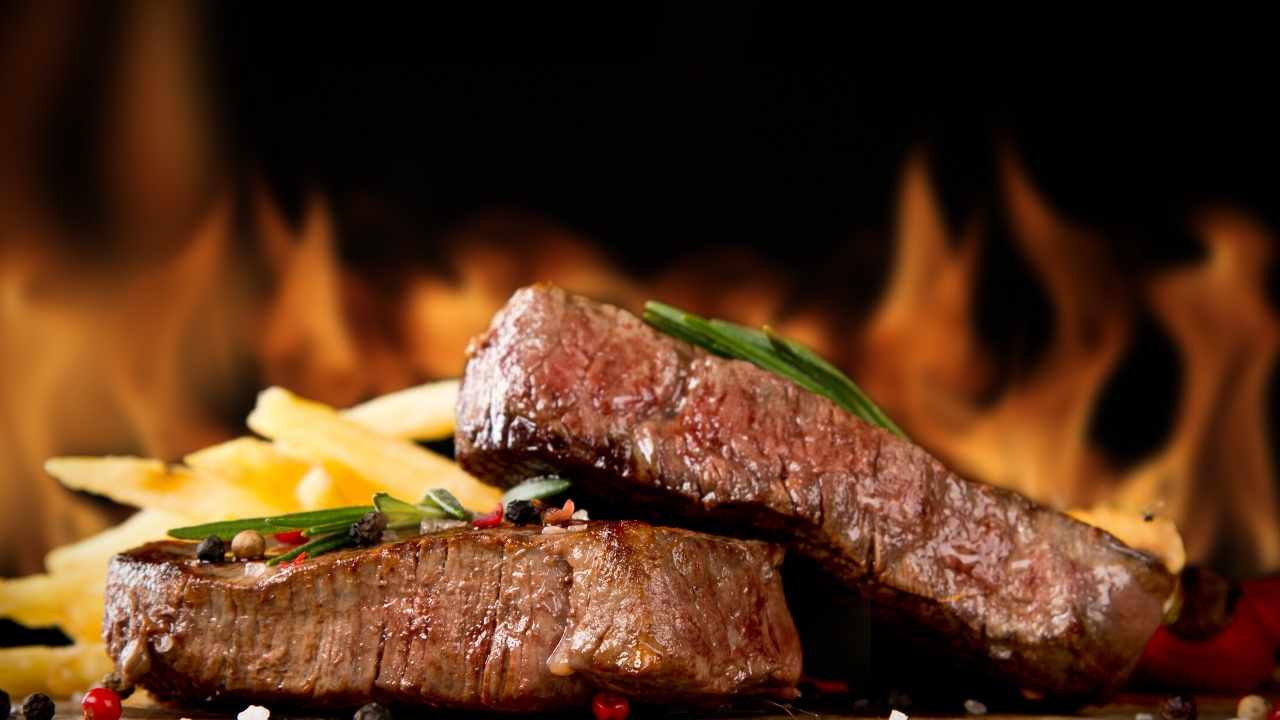 |
[TAG42]These hearty bowls feature roasted fajita veggies and halloumi cheese over beans and cilantro-lime rice. This recipe makes an amazing vegetarian dinner! I’m so |
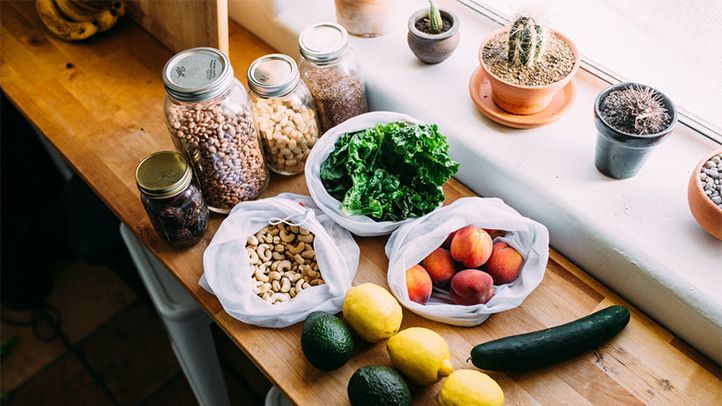 |
[TAG43]Following a plant-based diet (think vegan, vegetarian, or even flexitarian) is associated with a bevy of potential health benefits. That includes a lower risk |
 |
[TAG44]These thumbprint cookies offer classic shortbread flavor with dazzling jam centers. Using almond flour makes them gluten free and extra delicious! They’re |
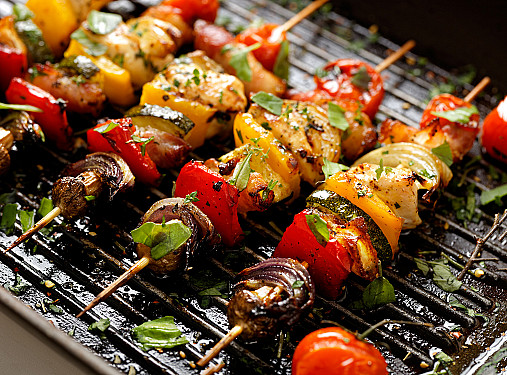 |
[TAG45]... |
 |
[TAG46]Ever tried artichoke in lasagna? If not, you’ve been missing out. This vegetarian recipe is freshly flavored, hearty and cheesy, but not too heavy. It’s a |
 |
[TAG47]Choosing more plant-based foods can help you eat a healthier diet. A Heart & Stroke dietitian explains how. |
 |
[TAG48]February is here! If you bookmarked any hearty soups and stews that you haven’t gotten to try yet, this is the month to make them. In just…The post What to |
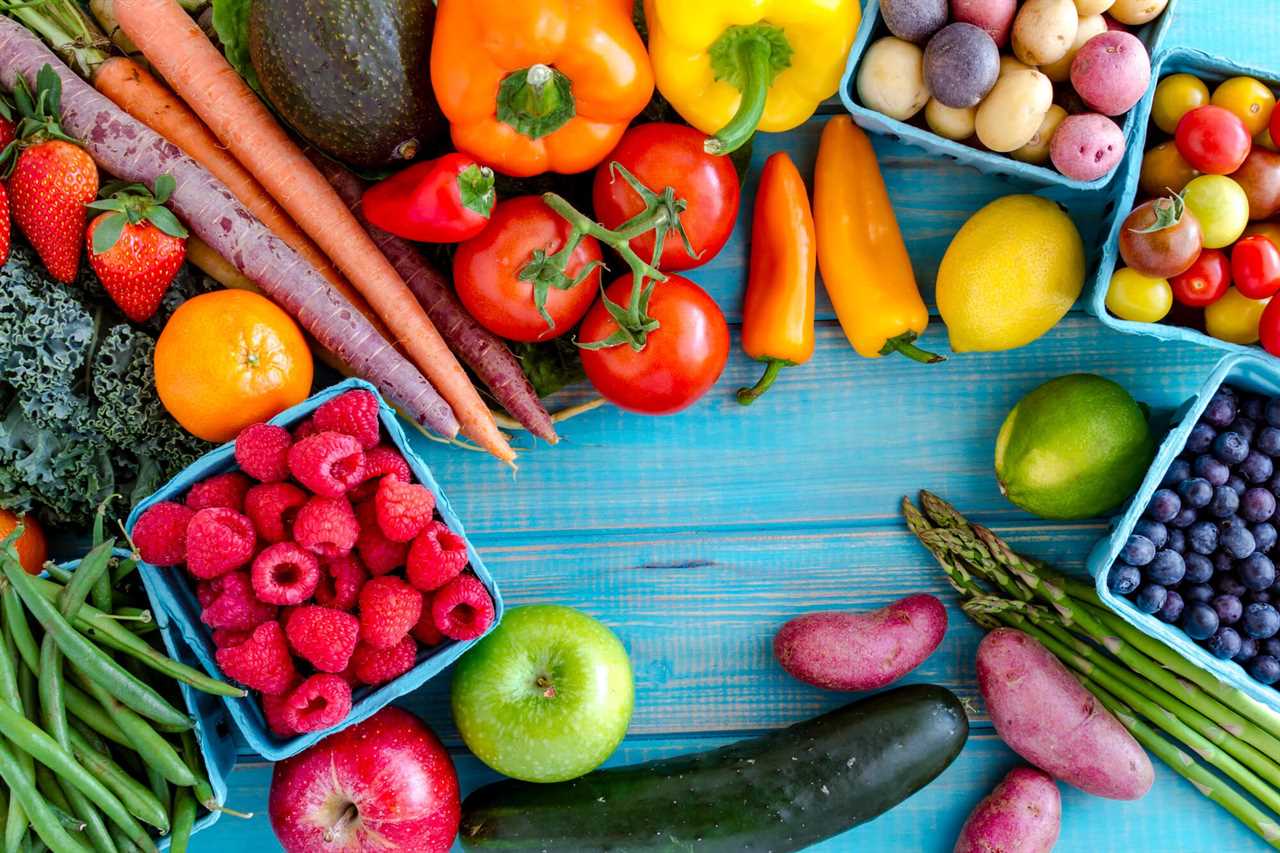 |
[TAG49]One of the most powerful steps you can take to improve your health is to move to a plant-based diet. We have everything you need to know to get started here |
 |
[TAG50]3 More Complete Plant-Based Proteins 👇🏾Part 2 Peace and blessings! Here is Part two to 3 of the complete plant-based proteins. A quick refresher: a |
 |
[TAG51]Whether you’re considering eating less meat or giving it up entirely. |
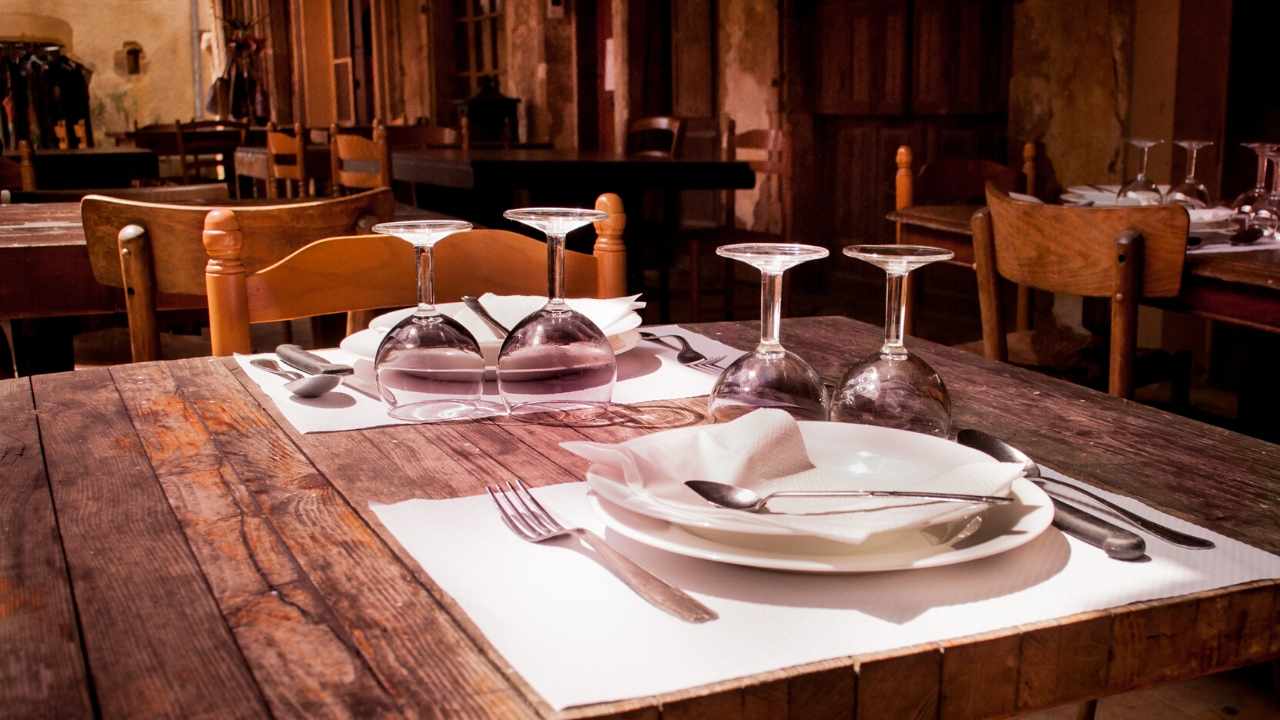 |
[TAG52]Let's talk about an evidence-based approach to preventing and treating chronic kidney disease with a whole food plant-based diet. What are the ideal foods to |
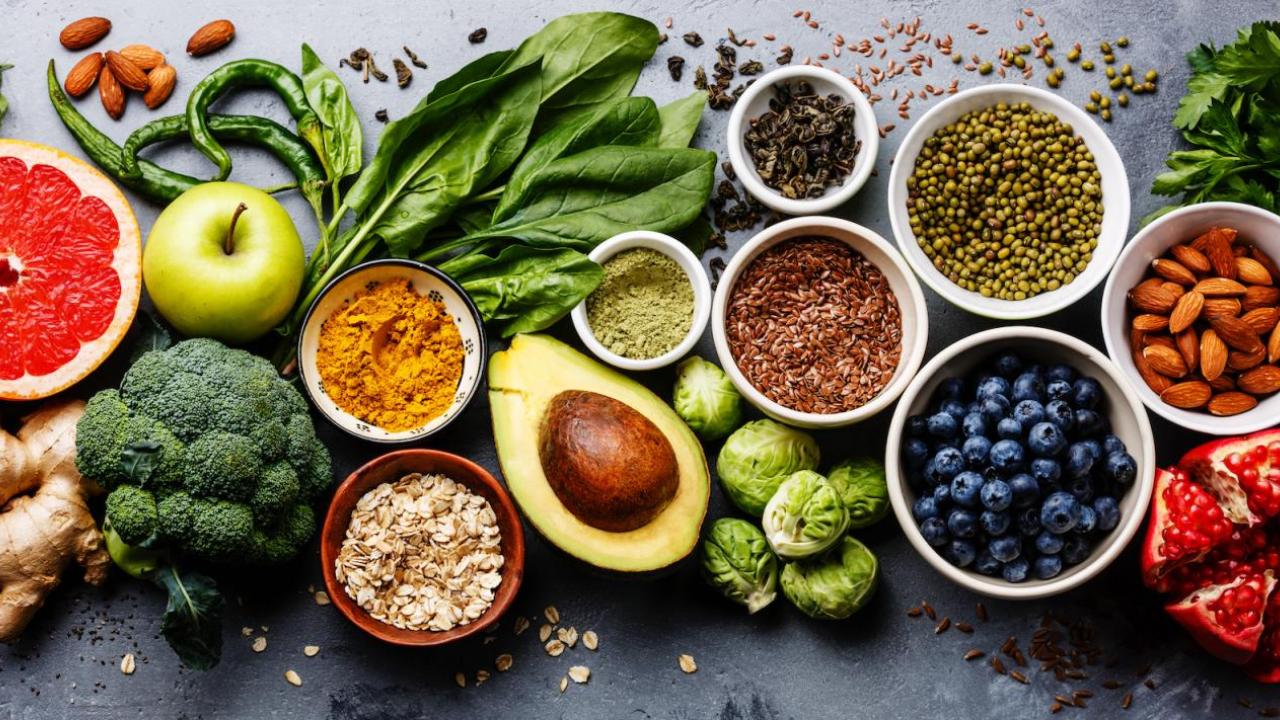 |
[TAG53]Columbia and NYP nutritionist Sabrina Toledano explains the benefits of a plant-based diet and how to get started. |
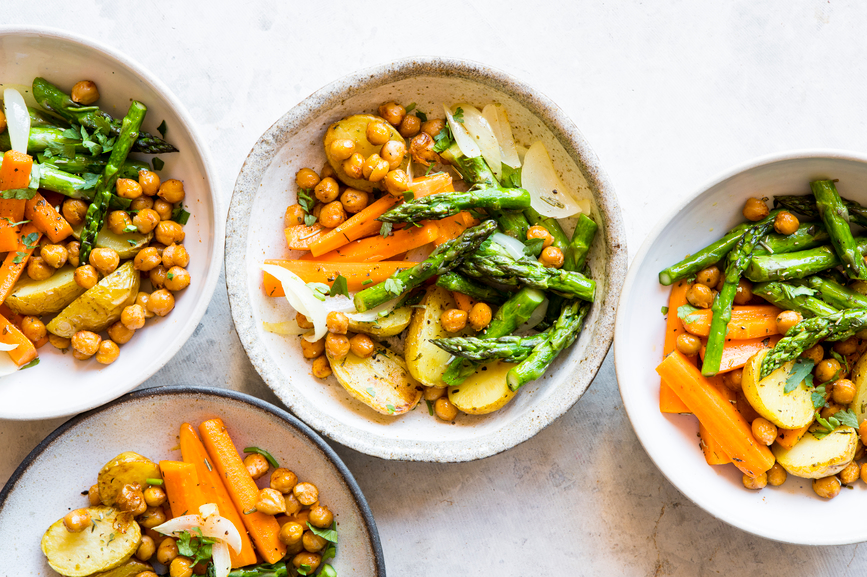 |
[TAG54]Hint: Your energy levels, gut microbiome, and environmental impact all win big. |

